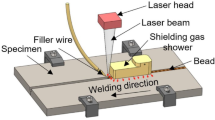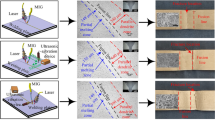Abstract
Oscillating laser could improve the welding stability and eliminate defects compared to the conventional laser welding. In this paper, the butt joints of 304 stainless steel with 8 mm thickness were made by oscillation laser welding. The relationship between the oscillating parameters, energy distribution, flow dynamics, formation, microstructure, and mechanical properties were established. The results showed that the oscillation amplitude largely affected energy density and size of the melt pool, while oscillation frequency had a notable effect on trajectory line energy and stability of the keyhole. Defects including collapse, spatters, and pores emerged when inappropriate oscillation parameters were used. Increased amplitude (0.9 to 1.5 mm) to reduce the spatter generation and lower frequency (300 to 100 Hz) to reduce the porosity of the weld (2.1 to 0.2%). Differences of the microstructure of the weld zone at different oscillation parameters were small owing to homogenization of temperature field and similarity of the thermal cycling profiles which leaded to a consistent process of structure evolution. Unequilibrium solidification processes in the molten pool increase dislocation density in the weld zone, resulted in welded joint with higher yield strengths than the base metal. On the other hand, tensile strength of the joint was little lower than that of base metal due to porosity defects. Under oscillation parameters of 1.5 mm–100 Hz, tensile strength of the welded joints reached 99.7% of base metal, and yield strength increased by 8.7% compared to the base material, indicating an acceptable welding quality.







Similar content being viewed by others
Data availability
All data generated or analyzed during this study are included in this article.
References
Milad M, Zreiba N, Elhalouani F et al (2008) The effect of cold work on structure and properties of aisi 304 stainless steel. J Mater Process Technol 203:80–85. https://doi.org/10.1016/j.jmatprotec.2007.09.080
Naeem M, Abuzer M, Sahi ST, Imran T (2023) Microcontroller-based thermoelectrically stabilized laser diode system. Arch Adv Eng Sci 1–7. https://doi.org/10.47852/bonviewAAES32021023
Yongbin Y, Bagherzadeh SA, Azimy H et al (2020) Comparison of the artificial neural network model prediction and the experimental results for cutting region temperature and surface roughness in laser cutting of al6061t6 alloy. Infrared Phys Technol 108:103364
Hafez KM, Katayama S (2009) Fiber laser welding of aisi 304 stainless steel plates. Q J Jpn Weld Soc 27:69s–73s. https://doi.org/10.2207/qjjws.27.69s
Yan J, Gao M, Zeng X (2010) Study on microstructure and mechanical properties of 304 stainless steel joints by tig, laser and laser-tig hybrid welding. Opt Lasers Eng 48:512–517. https://doi.org/10.1016/j.optlaseng.2009.08.009
Wang L, Rong Y (2022) Review on processing stability, weld defects, finite element analysis, and field assisted welding of ultra-high-power laser (≥ 10 kw) welding. Int J Hydromechatron 5:167–190
Zhang M, Chen G, Zhou Y et al (2014) Optimization of deep penetration laser welding of thick stainless steel with a 10kw fiber laser. Mater Des 53:568–576. https://doi.org/10.1016/j.matdes.2013.06.066
Kaplan AFH, Powell J (2011) Spatter in laser welding. J Laser Appl 23. https://doi.org/10.2351/1.3597830.
You D, Gao X, Katayama S (2015) Detection of imperfection formation in disk laser welding using multiple on-line measurements. J Mater Process Technol 219:209–220. https://doi.org/10.1016/j.jmatprotec.2014.12.025
Zhang M, Liu T, Hu R et al (2020) Understanding root humping in high-power laser welding of stainless steels: a combination approach. Int J Adv Manuf Technol 106:5353–5364. https://doi.org/10.1007/s00170-020-05021-6
Sun J, Feng K, Zhang K et al (2017) Fiber laser welding of thick aisi 304 plate in a horizontal (2g) butt joint configuration. Mater Des 118:53–65. https://doi.org/10.1016/j.matdes.2017.01.015
Wahba M, Mizutani M, Katayama S (2016) Single pass hybrid laser-arc welding of 25 mm thick square groove butt joints. Mater Des 97:1–6. https://doi.org/10.1016/j.matdes.2016.02.041
Üstündağ Ö, Fritzsche A, Avilov V et al (2018) Hybrid laser-arc welding of thick-walled ferromagnetic steels with electromagnetic weld pool support. Weld World 62:767–774. https://doi.org/10.1007/s40194-018-0597-3
Jiang M, Tao W, Chen Y et al (2019) Comparison of processing window in full penetration laser welding of thick high-strength steel under atmosphere and sub-atmosphere. Opt Laser Technol 109:449–455. https://doi.org/10.1016/j.optlastec.2018.08.023
Morawiec M, Różański M, Grajcar A et al (2017) Effect of dual beam laser welding on microstructure–property relationships of hot-rolled complex phase steel sheets. Arch Civ Mech Eng 17:145–153. https://doi.org/10.1016/j.acme.2016.09.007
Jiang Z, Chen X, Li H et al (2020) Grain refinement and laser energy distribution during laser oscillating welding of invar alloy. Mater Des 186:108195. https://doi.org/10.1016/j.matdes.2019.108195
Li Q, Luo M, Mu Z et al (2022) Improving laser welding via decreasing central beam density with a hollow beam. J Manuf Process 73:939–947. https://doi.org/10.1016/j.jmapro.2021.12.001
Zhang M, Wu J, Mao C et al (2022) Impact of power modulation on weld appearance and mechanical properties during laser welding of az31b magnesium alloy. Opt Laser Technol 156:108490. https://doi.org/10.1016/j.optlastec.2022.108490
Li Z, Rostam K, Panjehpour A et al (2020) Experimental and numerical study of temperature field and molten pool dimensions in dissimilar thickness laser welding of ti6al4v alloy. J Manuf Process 49:438–446. https://doi.org/10.1016/j.jmapro.2019.11.024
Jiang D, Alsagri AS, Akbari M et al (2019) Numerical and experimental studies on the effect of varied beam diameter, average power and pulse energy in nd: yag laser welding of ti6al4v. Infrared Phys Technol 101:180–188
Müller A, Goecke S, Sievi P et al (2014) Laser beam oscillation strategies for fillet welds in lap joints. Phys Procedia 56:458–466. https://doi.org/10.1016/j.phpro.2014.08.149
Hao K, Li G, Gao M et al (2015) Weld formation mechanism of fiber laser oscillating welding of austenitic stainless steel. J Mater Process Technol 225:77–83. https://doi.org/10.1016/j.jmatprotec.2015.05.021
Wang L, Gao M, Zeng X (2019) Experiment and prediction of weld morphology for laser oscillating welding of aa6061 aluminium alloy. Sci Technol Weld Join 24:334–341. https://doi.org/10.1080/13621718.2018.1551853
Wang L, Liu Y, Yang C et al (2021) Study of porosity suppression in oscillating laser-mig hybrid welding of aa6082 aluminum alloy. J Mater Process Technol 292:117053. https://doi.org/10.1016/j.jmatprotec.2021.117053
Hagenlocher C, Sommer M, Fetzer F et al (2018) Optimization of the solidification conditions by means of beam oscillation during laser beam welding of aluminum. Mater Des 160:1178–1185. https://doi.org/10.1016/j.matdes.2018.11.009
Chen G, Wang B, Mao S et al (2019) Research on the “∞”-shaped laser scanning welding process for aluminum alloy. Opt Laser Technol 115:32–41. https://doi.org/10.1016/j.optlastec.2019.01.046
Li J, Sun Q, Liu Y et al (2020) Melt flow and microstructural characteristics in beam oscillation superimposed laser welding of 304 stainless steel. J Manuf Process 50:629–637. https://doi.org/10.1016/j.jmapro.2019.12.053
Zhao H, Debroy T (2001) Weld metal composition change during conduction mode laser welding of aluminum alloy 5182. Metall Mater Trans B Process Metall Mater Process Sci 32:163–172. https://doi.org/10.1007/s11663-001-0018-6
Chen L, Wang C, Mi G et al (2021) Effects of laser oscillating frequency on energy distribution, molten pool morphology and grain structure of aa6061/aa5182 aluminum alloys lap welding. J Market Res 15:3133–3148
Li S, Mi G, Wang C (2020) A study on laser beam oscillating welding characteristics for the 5083 aluminum alloy: morphology, microstructure and mechanical properties. J Manuf Process 53:12–20. https://doi.org/10.1016/j.jmapro.2020.01.018
Acknowledgements
We would like to express our deep gratitude to the Analysis and Test Center of HUST (Huazhong University of Science and Technology), the State Key Laboratory of Material Processing and Die & Mould Technology and the State Key Laboratory of Digital Manufacturing Equipment & Technology of HUST, for their friendly cooperation.
Funding
This work was supported by the National Natural Science Foundation of China (Grant No. 52105338 and No. 52188102).
Author information
Authors and Affiliations
Contributions
All authors contributed to the study’s conception and design. Peikang Tao: methodology, writing—original draft preparation, data curation, visualization. Xiong Zhang: conceptualization, methodology, writing review and editing, project management. Chunming Wang: methodology and materials. Gaoyang Mi: conceptualization, methodology. Yu Huang: writing review and editing. All authors have read and agreed to the published version of the manuscript.
Corresponding author
Ethics declarations
Ethics approval
Not applicable.
Consent to participate
Not applicable.
Consent for publication
Not applicable.
Competing interests
The authors declare no competing interests.
Additional information
Publisher's Note
Springer Nature remains neutral with regard to jurisdictional claims in published maps and institutional affiliations.
Rights and permissions
Springer Nature or its licensor (e.g. a society or other partner) holds exclusive rights to this article under a publishing agreement with the author(s) or other rightsholder(s); author self-archiving of the accepted manuscript version of this article is solely governed by the terms of such publishing agreement and applicable law.
About this article
Cite this article
Tao, P., Wang, C., Mi, G. et al. Formation, microstructure, and mechanical properties of oscillating laser-welded joints of 8-mm 304 stainless steel. Int J Adv Manuf Technol 130, 2899–2913 (2024). https://doi.org/10.1007/s00170-023-12868-y
Received:
Accepted:
Published:
Issue Date:
DOI: https://doi.org/10.1007/s00170-023-12868-y




